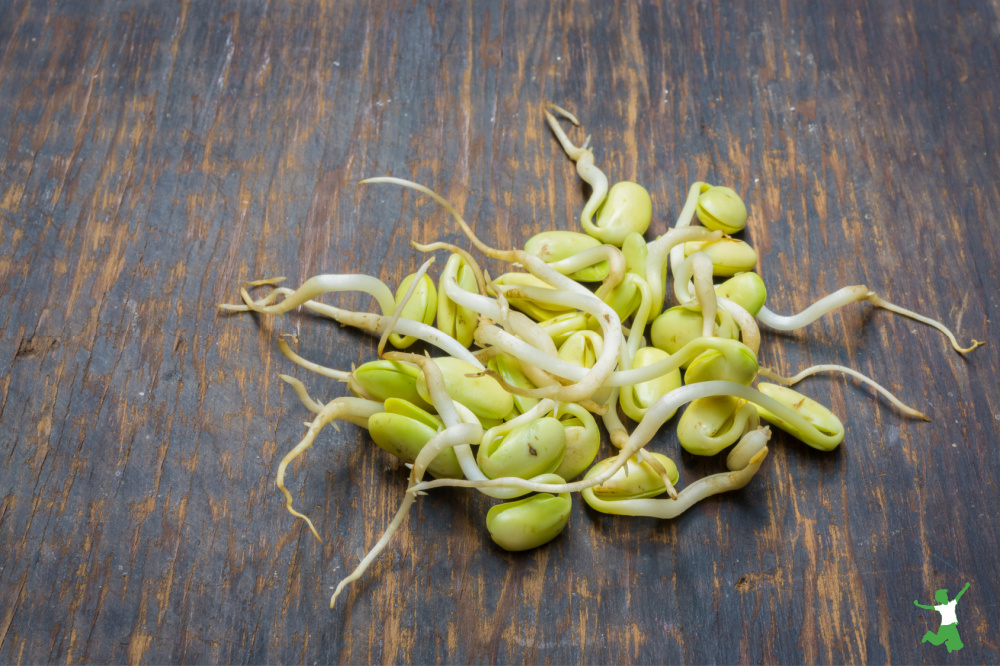The paradoxical reasons why sprouted soy contains more antinutrients than unsprouted versions and should be avoided in the diet to preserve gastrointestinal and hormonal health.

Great news abounds with regard to the public’s perception of soy.
There’s no doubt that more people than ever are getting the message that soy is not the “health food” that it is portrayed to be by conventional dietary authorities.
Soybeans in the diet pose a danger to health even in menopausal women.
This includes the innocuous green bean known as edamame.
The bad news is that a little information can sometimes be dangerous!
Sprouted Soy Myths
In this case, it appears that many who recognize that soy is an unhealthy food are under the mistaken impression that sprouted soy is fine to consume.
Or, just as bad, some believe that organic soy or soy that is certified GMO-free poses no problem to health.
Perhaps the healthy traditional practice of sprouting grains, legumes, and other seeds resulted in confusion about soy because it is a legume.
Or maybe it’s the GMO issue that is triggering confusion. Some seem to assume that the reason soy is bad is because nearly all of it is genetically modified.
Sprouting Soybeans Does Not Make Them Safe
Even food manufacturers are on the bandwagon of misinformation about this issue.
Some supposedly wholesome sprouted bread and pasta brands (like Ezekiel) include sprouted soy and actually market this as “healthy” on the label!
Some vegetarian and vegan websites are promoting recipes for sprouted soy milk as nutritious alternatives to (undigestible) regular soya milk and dairy.
Let’s set the record straight on this important issue.
Any form of soy with the exception of fermented nonGMO soy in small condimental amounts should be avoided in the diet.
Soy was an unhealthy food to consume long before the issue of GMO soy came into play.
The fact that most of the soy on the market these days is GMO just makes what was already an unhealthy food even worse!
With regard to sprouted soy, be on guard to avoid being fooled! It’s actually more harmful than unsprouted soy!
Traditional Uses of Soy Sprouts
Dr. Kaayla Daniel, author of The Whole Soy Story reveals why soy sprouts must be avoided in the diet:
Soy sprouts, by the way, are not healthy. Short-term germination increases the strength of soy‘s antinutrient fractions.[emphasis mine] In contrast, long-term sprouting plus fermentation will decrease and nearly eliminate them. (1)
She goes on to describe the historical usage of sprouted soy, which did not include regular consumption!
Soy sprouts are mentioned in historical accounts as useful, sometime pharmaceuticals, not as a daily food. (2)
Antinutrients Block Minerals
The Weston A. Price Foundation concurs, warning that high levels of phytic acid even in sprouted soy reduce the assimilation of calcium, magnesium, copper, iron, and zinc.
Phytic acid in soy is not neutralized by ordinary preparation methods such as soaking, sprouting and long, slow cooking. High phytate diets have caused growth problems in children. (3)
Phytic acid also blocks mineral absorption, causes digestive distress, and can contribute to tooth decay. The late Rami Nagel details this important information in his bestselling book Cure Tooth Decay.
In short, soy that is organic, nonGMO, and sprouted is not safe to eat. This is the case despite some food philosophies that embrace it as such.
The Only Safe Way to Consume Soy
NonGMO, fermented soy in small, condimental amounts as practiced in traditional Asian cultures is the only safe way to consume this legume. Those who have thyroid conditions should still avoid it, however, due to the goitrogens.
One of the most popular examples of cultured soybeans is miso. Sushi restaurants in Western countries seem to always feature miso soup on the menu (though it is usually GMO).
Tempeh, natto, and traditionally brewed soy sauce also fall under the healthy soy category. The nutritional benefits of natto, in particular, are unequaled by any other soy food.
Everything else soy? Just pass!
(1-2) The Whole Soy Story
(3) Soy Alert!








This isn’t really about soy but I wanted to put the comment on a recent post so hopefully I would get a response.
I live in Ontario, Canada where raw milk is illegal to be sold or distributed. I know there are some people who have been able to get it by knowing a farmer and on the qt they get milk from him. I don’t know any farmers. While this law is being challenged in the courts, at the moment I cannot get raw milk. If I buy organic milk can I make whey from that? It might not have all the benefits of raw milk whey but would it have enough to make it worthwhile?
Thanks. for your information.
you can get kefir grains and culture your store bought milk to restore the enzymes. I’m sure you can search “milk kefir” or just “kefir” on this blog to find how to make it. you have to buy kefir grains. I haven’t bothered with it because I can get raw milk, but from what I understand it’s simple. Something like adding the grains to milk, letting it sit for a while, and then straining them out.
You could strain yogurt for whey. Buy good quality plain yogurt
What about Bragg’s Liquid Aminos?
No, it is not fermented. Ohsawa Nama Shoyu is produced in the traditional way.
Korean tofu is a whole different animal than almost any other tofu. The soy beans for Korean tofu are soaked and fermented for a period of 3-5 days before being lightly cooked and pressed into milk. I have had real Korean tofu and have made it myself a few times. I think it’s delicious, but it is much stronger tasting than other tofus and also has a softer texture, even the “firm” variety is softer than conventional firm tofu. Unfortunately, it’s very difficult to find in the states, and because it’s time and labor intensive, even most Korean restaurants won’t make it. You have to find an old, Korean Grandmother to get the real stuff. 🙂
Rachel mentioned the Korean use of soybean sprouts, not tofu.
Sarah, just to let you know that the sprouts in the picture you have on this post look like mung bean sprouts to me. Soybean sprout is bigger and has a long spindly tail.
I am Asian of Chinese origin and we eat bean sprouts quite regularly, a little here and there and also as a main stirfry vegetable dish. Now the Koreans eat soybean sprouts so much more, almost every hotpot they make have those sprouts in them (and tofu too!) and they do not seem to suffer much of these goitrogenic ailments etc that we are talking about. I have gone through many diets and ways of eating and I finally come to the conclusion that for me, moderation in all things is best. I think we still don’t know everything there is to know about soy.
Thank you for the reality check. As you say, Sarah, a little information can sometimes be dangerous. With today’s scientific knowledge, I don’t think we can say any food is off limits & terrible for your health, except maybe margarine and similar processed vegetable oils. Dr Price would surely agree that he did not study every traditional diet, and also that the cultures he did study subsisted on a wide variety of foods. My motto is also moderation, & I am always open to new information, with the realization that our knowledge of food & nutrition is still developing.
Sarah gets this. Why and how Price-Pottenger Nutrition Foundation does not is beyond me. They have endorsed Food for Life sprouted soy products. Come on!
I would take this a step further. Ramiel Nagel’s work shows sprouting is not enough to deal with grains and legumes. I ferment mine for days. So if I were to eat soy, which I don’t, I would sprout and ferment or ferment for a very long time.
Soy is a healthy food as long as it is a non-GMO variety, there is so much confusion, sprouting is the best to maximize the nutrients. In Thailand soy is not good bec almost ALL their their foods are GMOs, but just like anything it should be taken in moderation, the phytoestrogen in soy is not the same as the estrogen female hormones, it can only mimic the benefits of estrogen when necessary.
The main issues with almond milk are the synthetic vitamins. Better off making your own ! And it’s easy!!
It’s a shame they put soy in everything. If it’s healthy for the Japanese we have to load up on it! At my grocery store when I look for organic frozen veggies the majority is edamame. I guess that is all anybody wants. I was fooled too, once upon a time and ate it. As for the bread I just make my own sourdough bread. Thanks for clearing up the question of soy, Sarah.
For those that like Ezekiel bread, the same company (Food for Life) makes one without soy. It looks just like the Ezekiel breads, but it’s in a red wrapper and is just called “7 sprouted grain” or something like that. No sprouted soy.
What about mung bean sprouts? Is it just soy or all legumes?
It is not all legumes. Peas & beans should be Ok. I am unclear about edamame, though.
Just soy.